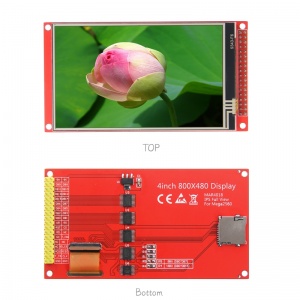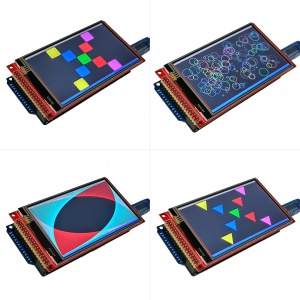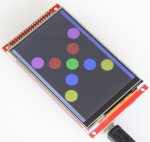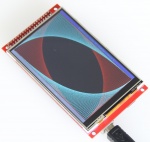More actions
| (5 intermediate revisions by one other user not shown) | |||
| Line 6: | Line 6: | ||
}} | }} | ||
== <font color="blue">Product Picture</font> == | == <font color="blue">Product Picture</font> == | ||
[[File: | [[File:3.97-Mega2560-红色-6.jpg|300px]] | ||
[[File:3.97-Mega2560-红色-2pin-2.jpg|300px]] | |||
[[File:3.97-Mega2560-4pin.jpg|300px]] | |||
==<font color="blue">Product Description</font> == | ==<font color="blue">Product Description</font> == | ||
| Line 81: | Line 83: | ||
==<font color="blue">Interface Definition</font> == | ==<font color="blue">Interface Definition</font> == | ||
[[file: | [[file:MAR4018-002.png|600px]] | ||
The blue box in the above figure is the 8-bit/16-bit data bus mode switch, which is described as follows: | |||
:Solder '''R4''' with 0Ω resistor or short circuit directly, and disconnect '''R5''': Select '''16'''-bit data bus mode (default),use '''DB0~DB15''' data pin | |||
:Solder '''R5''' with 0Ω resistor or short circuit directly, and disconnect '''R4''': Select '''8'''-bit data bus mode use '''DB0~DB7''' data pin | |||
{| class="wikitable" border="1" style="width: 800px; background-color: white;" | {| class="wikitable" border="1" style="width: 800px; background-color: white;" | ||
| Line 99: | Line 106: | ||
|- | |- | ||
| align="center" |3 | | align="center" |3 | ||
| align="center" | | | align="center" |DB8 | ||
| | |8th bit of data bus | ||
| align="center" |4 | | align="center" |4 | ||
| align="center" | | | align="center" |DB9 | ||
| | |9th bit of data bus | ||
|- | |- | ||
| align="center" |5 | | align="center" |5 | ||
| align="center" | | | align="center" |DB10 | ||
| | |10th bit of data bus | ||
| align="center" |6 | | align="center" |6 | ||
| align="center" | | | align="center" |DB11 | ||
| | |11th bit of data bus | ||
|- | |- | ||
| align="center" |7 | | align="center" |7 | ||
| align="center" | | | align="center" |DB12 | ||
| | |12th bit of data bus | ||
| align="center" |8 | | align="center" |8 | ||
| align="center" | | | align="center" |DB13 | ||
| | |13h bit of data bus | ||
|- | |- | ||
| align="center" |9 | | align="center" |9 | ||
| align="center" | | | align="center" |DB14 | ||
| | |14th bit of data bus | ||
| align="center" |10 | | align="center" |10 | ||
| align="center" | | | align="center" |DB15 | ||
| | |15th bit of data bus | ||
|- | |- | ||
| align="center" |11 | | align="center" |11 | ||
| Line 155: | Line 162: | ||
|- | |- | ||
| align="center" |19 | | align="center" |19 | ||
| align="center" | | | align="center" |RS | ||
|LCD register / data selection signal | |LCD register / data selection signal | ||
Low level: register, high level: command | Low level: register, high level: command | ||
| align="center" |20 | | align="center" |20 | ||
| align="center" | | | align="center" |WR | ||
|LCD write control signal | |LCD write control signal | ||
|- | |- | ||
| align="center" |21 | | align="center" |21 | ||
| align="center" | | | align="center" |CS | ||
|LCD screen select control signal, low level enable | |LCD screen select control signal, low level enable | ||
| align="center" |22 | | align="center" |22 | ||
| align="center" | | | align="center" |RST | ||
|LCD reset control signal, low reset | |LCD reset control signal, low reset | ||
|- | |- | ||
| Line 173: | Line 180: | ||
|Undefined, reserved | |Undefined, reserved | ||
| align="center" |24 | | align="center" |24 | ||
| align="center" | | | align="center" |RD | ||
|LCD read control signal | |LCD read control signal | ||
|- | |- | ||
| align="center" |25 | | align="center" |25 | ||
| align="center" | | | align="center" |T_IRQ | ||
|Touch screen interrupt control signal, low level when touch is detected | |Touch screen interrupt control signal, low level when touch is detected | ||
| align="center" |26 | | align="center" |26 | ||
| Line 205: | Line 212: | ||
|- | |- | ||
| align="center" |33 | | align="center" |33 | ||
| align="center" | | | align="center" |CLK | ||
|SPI bus clock signal | |SPI bus clock signal | ||
| align="center" |34 | | align="center" |34 | ||
| align="center" | | | align="center" |T_CS | ||
|SD card select control signal, low level enable | |SD card select control signal, low level enable | ||
|- | |- | ||
| Line 223: | Line 230: | ||
{| class="FCK__ShowTableBorders" align="left" | {| class="FCK__ShowTableBorders" align="left" | ||
|- | |- | ||
![[file: | ![[file:MAR4018-003.png|无框|400x400px]] | ||
|- | |- | ||
| align="center" | '''Arduino Mega2560 direct insertion picture''' | | align="center" | '''Arduino Mega2560 direct insertion picture''' | ||
| Line 265: | Line 272: | ||
==<font color="blue">Program Download</font> == | ==<font color="blue">Program Download</font> == | ||
* [http://www.lcdwiki.com/res/Program/Arduino/ | * [http://www.lcdwiki.com/res/Program/Arduino/4.0inch/Mega2560_8_16BIT_NT35510_MAR4018_V1.0/4.0inch_Arduino_Mega2560_8%2616BIT_Module_NT35510_800x480_MAR4018_V1.0.zip '''4.0 inch Arduino Mega2560 module package'''] | ||
==<font color="blue">Product Documentation</font> == | ==<font color="blue">Product Documentation</font> == | ||
* [http://www.lcdwiki.com/res/ | * [http://www.lcdwiki.com/res/MAR4018/4.0inch_Arduino_Mega2560_8&16BIT_Module_MAR4018_User_Manual_EN.pdf '''4.0 inch Arduino Mega2560 Module User Manual'''] | ||
* [http://www.lcdwiki.com/res/ | * [http://www.lcdwiki.com/res/MAR4018/4.0inch_MAR4018_Size.pdf '''4.0 inch Arduino Mega2560 Module Size Picture'''] | ||
* [http://www.lcdwiki.com/res/ | * [http://www.lcdwiki.com/res/MAR4018/QD-TFT3971_Specification_V1.0.pdf '''4.0 inch LCD Specification'''] | ||
* [http://www.lcdwiki.com/res/ | * [http://www.lcdwiki.com/res/MAR4018/Altium_Package_library.zip '''4.0 inch TFT LCD Schematic and PCB Package Library'''] | ||
* [http://www.lcdwiki.com/res/MAR4018/NT35510_Preliminary_V0.80.pdf '''Driver IC NT35510 Data sheet'''] | |||
==<font color="blue">Reference Materials</font> == | ==<font color="blue">Reference Materials</font> == | ||
Latest revision as of 11:17, 30 July 2022
Product Picture
Product Description
- Support Arduino Mega2560 direct plug-in use
- 4.0-inch color screen, support 16BIT RGB 65K color display, display rich colors
- 800x480 resolution for clear display
- Supports 8-bit and 16-bit parallel bus transmission with fast transfer speed
- On-board 5V/3.3V level shifting IC, compatible with 5V/3.3V operating voltage
- Support touch function
- Provides an Arduino library with a rich sample program
- Available on C51 and STM32 platforms with a rich sample program
- Easy to expand the experiment with SD card slot
- Military-grade process standards, long-term stable work
- Provide underlying driver technical support
Product Parameters
| Name | Parameter |
| Display Color | RGB 65K color |
| SKU | MAR4018 |
| Screen Size | 4.0(inch) |
| Type | TFT |
| Driver IC | NT35510 |
| Resolution | 800*480 (Pixel) |
| Module Interface | 8Bit or 16Bit parallel interface |
| Touch Screen Type | Resistance touch screen |
| Touch IC | XPT2046 |
| Active Area | 86.40x51.84(mm) |
| Module PCB Size | 58.65x108.48 (mm) |
| back light | 8 chip HighLight white LEDs paralle |
| Operating Temperature | -10℃~60℃ |
| Storage Temperature | -20℃~70℃ |
| Operating Voltage | 5V |
| Power Consumption | TBD |
| Product Weight(Package containing) | 60 (g) |
Interface Definition
The blue box in the above figure is the 8-bit/16-bit data bus mode switch, which is described as follows:
- Solder R4 with 0Ω resistor or short circuit directly, and disconnect R5: Select 16-bit data bus mode (default),use DB0~DB15 data pin
- Solder R5 with 0Ω resistor or short circuit directly, and disconnect R4: Select 8-bit data bus mode use DB0~DB7 data pin
| Number | Module Pin | Pin Description | Number | Module Pin | Pin Description |
|---|---|---|---|---|---|
| 1 | 5V | Positive power supply | 2 | 5V | Positive power supply |
| 3 | DB8 | 8th bit of data bus | 4 | DB9 | 9th bit of data bus |
| 5 | DB10 | 10th bit of data bus | 6 | DB11 | 11th bit of data bus |
| 7 | DB12 | 12th bit of data bus | 8 | DB13 | 13h bit of data bus |
| 9 | DB14 | 14th bit of data bus | 10 | DB15 | 15th bit of data bus |
| 11 | DB7 | 7th bit of data bus | 12 | DB6 | 6th bit of data bus |
| 13 | DB5 | 5th bit of data bus | 14 | DB4 | 4th bit of data bus |
| 15 | DB3 | third bit of data bus | 16 | DB2 | 2nd bit of data bus |
| 17 | DB1 | 1st bit of data bus | 18 | DB0 | 0 bit of data bus |
| 19 | RS | LCD register / data selection signal
Low level: register, high level: command |
20 | WR | LCD write control signal |
| 21 | CS | LCD screen select control signal, low level enable | 22 | RST | LCD reset control signal, low reset |
| 23 | NC | Undefined, reserved | 24 | RD | LCD read control signal |
| 25 | T_IRQ | Touch screen interrupt control signal, low level when touch is detected | 26 | NC | Undefined, reserved |
| 27 | NC | Undefined, reserved | 28 | NC | Undefined, reserved |
| 29 | SD_CS | SD card select control signal, low level enable | 30 | NC | Undefined, reserved |
| 31 | MISO | SPI bus input signal | 32 | MOSI | Touch screen chip select control signal, low level enable |
| 33 | CLK | SPI bus clock signal | 34 | T_CS | SD card select control signal, low level enable |
| 35 | GND | Power ground | 36 | GND | Power ground |
Connect to Arduino
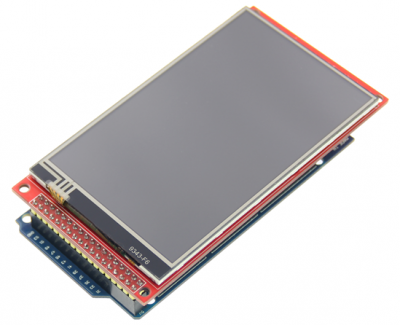
|
|---|
| Arduino Mega2560 direct insertion picture |
How to use on Arduino
- Step 1: Download the test program
- Download the Arduino test program from the Program Download column
- For a description of the relevant test procedures, please refer to the test program documentation in the package
- Step 2: Connect the Arduino development board
- Plug the module directly into the Arduino development board ( Do not plug in?)
- After the module is plugged in, power on the Arduino board
- Step 3: Copy the dependent library
- Make sure the Arduino IDE is installed on your computer (if it is not installed: Arduino IDE download URL)
- After installing the Arduino IDE, you need to copy the dependent library to the Arduino project directory as follows:
- (1) Decompress the downloaded test package
- (2) Copy the dependent libraries in the Install libraries directory in the package (shown below) to the libraries folder
- of the Arduino project directory ( Don't know the Arduino project directory?)

- Step 4: Compile and download the program to the development board
- Open the sample in the Example directory of the package to test, compile and download( Don't know how to compile and download?)
- Step 5: Observe the running of the program
- After the program is downloaded, run it directly and observe the running status. If it can be displayed normally, the program runs
- successfully, as shown in the following figure (take the colligate_test test program as an example):
Program Download
Product Documentation
- 4.0 inch Arduino Mega2560 Module User Manual
- 4.0 inch Arduino Mega2560 Module Size Picture
- 4.0 inch LCD Specification
- 4.0 inch TFT LCD Schematic and PCB Package Library
- Driver IC NT35510 Data sheet
Reference Materials
- Arduino IDE software use illustration
- C51 Keil and stc-isp software use illustration
- STM32 keil software use illustration
- PCtoLCD2002 software use illustration
- Image2Lcd software use illustration
- Chinese and English display modulo settings


